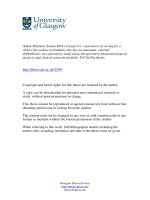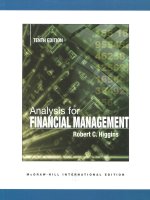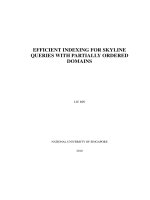Model calibration for financial assets with mean reverting price processes
Bạn đang xem bản rút gọn của tài liệu. Xem và tải ngay bản đầy đủ của tài liệu tại đây (5.98 MB, 60 trang )
MODEL CALIBRATION FOR FINANCIAL
ASSETS WITH MEAN-REVERTING PRICE
PROCESSES
CHEN DIHUA
(BSc(Hons), NUS)
A THESIS SUBMITTED
FOR THE DEGREE OF MASTER OF SCIENCE
DEPARTMENT OF MATHEMATICS
NATIONAL UNIVERSITY OF SINGAPORE
2006
I appreciate the mathematics underlying the financial market.
Acknowledgements
This is my thesis for the degree of Master of Science, NUS. It cannot be accomplished without the following people’s guidance, encouragement and support.
First of all, I would like to express my heartfelt gratitude to my supervisor,
Associate Professor Zhao Gongyun, who is also my supervisor on my BSc honor
year project. Throughout these years, I benifit a lot from his profound knowledge
and rigorous scholarship. Prof Zhao offers me invaluable guidance on my research
work. On converting my MSc candidature into a part-time track and starting
working in DBS, he reminded me of the importance of laying a solid mathematical
foundation in doing quantitative jobs. I shall keep this advice in mind and continue
to try my best.
I wish to thank Dr Dai Min, Dr Li Xun and Dr Jin Xing for bringing me into the
area of financial mathematics. Besides conducting useful courses, Dr Dai Min and
Dr Li Xun organized weekly seminars which raise my great interest in this area;
Dr Jin Xing offered me many valuable suggestions and helps during my study in
NUS.
The courses taken in Department of Mathematics and Department of Computational Science, NUS, provide a foundation for my research work. I shall sincerely
thank Prof Zhao Gongyun, Prof Sun Defeng and Dr Tan Geok Choo for teaching
iii
Acknowledgements
iv
me Optimizaiton and Operations Research; thank Prof Lin Ping, Prof Chu Delin
and Prof Bao Weizhu for teaching me Numerical Methods; thank Prof Wang Jiansheng and Prof Zhang Donghui for teaching me programming skill and modelling
technique; thank Prof Chew Tuan Seng, Prof Denny Leung and Prof To Wing
Keung for teaching me real and complex analysis; and so on.
The second half of my candidature is based on a part-time track and during
the time I started my job in DBS Bank as a quantitative analyst. I wish to express
my sincere acknowledgement to the team leader, Senior Vice President, Dr Liu
Xiaoqing, who is a talented quant with deep insight. Under his guidance, I have
been engaged in the research on interest rate model calibration, which results in
the second part of the thesis. Moreover, Dr Liu brings me onto the right track of
becoming a quant and offers me continuous guidance and tolerance in daily work.
I am deeply grateful to my parents for their support in so many years.
Thanks are also due to all the people who have given me help.
Contents
Acknowledgements
iii
Abstract
vii
1 Introduction
1
2 Recovery of Local Volatility for Schwartz(1997) Model
4
2.1
Local volatility model . . . . . . . . . . . . . . . . . . . . . . . . . .
4
2.2
Formulation as an Inverse Parabolic Problem . . . . . . . . . . . . .
6
2.3
An Optimal Control Framework . . . . . . . . . . . . . . . . . . . .
10
2.4
Numerical Solution . . . . . . . . . . . . . . . . . . . . . . . . . . .
14
2.4.1
An iterative algorithm . . . . . . . . . . . . . . . . . . . . .
14
2.4.2
Removing the initial discontinuity . . . . . . . . . . . . . . .
16
2.4.3
Numerical example . . . . . . . . . . . . . . . . . . . . . . .
17
Conclusion . . . . . . . . . . . . . . . . . . . . . . . . . . . . . . . .
19
2.5
3 Calibration for Hull-White Interest Rate Model
21
3.1
Hull-White Interest Rate Model . . . . . . . . . . . . . . . . . . . .
21
3.2
Problems with Tree Implementation . . . . . . . . . . . . . . . . . .
25
3.2.1
Brief description of tree calibration procedure . . . . . . . .
25
3.2.2
Problems with tree implementation . . . . . . . . . . . . . .
29
Calibration based on analytical formulae . . . . . . . . . . . . . . .
30
3.3
v
CONTENTS
3.4
3.5
vi
3.3.1
Step1 - Calibration to the caplet volatilities . . . . . . . . .
31
3.3.2
Step2 - Calibration to the yield curve . . . . . . . . . . . . .
34
Distribution Correction for Negative Rate Removal . . . . . . . . .
38
3.4.1
Approach one . . . . . . . . . . . . . . . . . . . . . . . . . .
39
3.4.2
Approach two . . . . . . . . . . . . . . . . . . . . . . . . . .
40
3.4.3
Comparison of the corrected distribution and the original
distribution . . . . . . . . . . . . . . . . . . . . . . . . . . .
44
Conclusion . . . . . . . . . . . . . . . . . . . . . . . . . . . . . . . .
47
Bibliography
47
Abstract
This thesis discusses the model calibration for financial assets with mean-reverting
price processes, which is an important topic in mathematical finance.
The first part focuses on the recovery of local volatility from market data for
Schwartz(1997) model. We formulate it as an inverse parabolic problem, and derive
the necessary condition for determining the local volatility under the optimal control framework. An iterative algorithm is provided to solve the optimality system
and a synthetic numerical example is provided to illustrate the effectiveness.
The second part is devoted to the model parameter calibration and distribution
correction for Hull-White interest rate model. We propose an efficient-yet-precise
calibration technique which uses the analytical tractability of the model. To remove
the occurrence of negative rates, a distribution correction method is proposed based
on weighted Monte-Carlo simulation. Our method has a notable advantage that it
can still preserve the calibration to the market data.
Key Words: Model calibration, Mean-reverting process, Inverse problem, Optimal control, Distribution correction, Weighted Monte-Carlo simulation.
vii
Chapter 1
Introduction
Stochastic models for the evolution of the financial assets’ prices are at the core of
the mathematical finance. Pricing of a derivative product begins with a reasonable
modelling of its underlying asset price process.
In the celebrated Black-Scholes model (Black & Scholes (1973)), the price of a
stock S, is assumed to follow the Geometric Brownian motion
dSt = µSt dt + σSt dWt ,
(1.1)
where µ is the drift, σ is the volatility and Wt is a standard Brownian motion.
For other financial asset such as a physical commodity, its spot price exhibits
mean-reverting nature, because of the supply and demand fluctuations and the
fixed costs of adjusting the long-term supply of a commodity or the fixed costs of
shifting consumption from one commodity to another. In this case, a Geometric
Brownian motion as in the Black-Scholes model cannot properly capture its price
behavior, a mean-reverting stochastic process is expected.
A simple mean-reverting model for an asset price is represented by the following
1
CHAPTER 1. INTRODUCTION
2
Ornstein-Uhlenbeck process:
dSt = α(µ − St )dt + σdWt ,
(1.2)
where α is the mean-reverting rate, µ is the long-term mean-reverting level, Wt is
a standard Brownian motion and σ is the volatility.
In this model, the price mean reverts to the long-term level µ at a speed given
by the mean-reverting rate α, which is taken to be strictly positive. If the spot
price is above the long-term level µ, then the drift of the spot price will be negative
and the price will tend to revert back towards the long-term level. Similarly, if the
spot price is below the long-term level then the drift will be positive and the price
will tend to move back towards µ. Note that at any point in time the spot price
will not necessarily move back towards the long-term level as the random change
in the spot price may be of the opposite sign and greater in magnitude than the
drift component.
The stochastic models typically incorporate some parameters (e.g. volatility,
mean-reverting rate and long-term mean-reverting level, etc, in the above (1.1) and
(1.2)) that may be constants or deterministic functions. The successful application
of the model in pricing, hedging and other trading activities will critically depend
on how the parameters are specified.
Usually, these parameters are not directly observable in the market. One needs
to estimate the parameters by calibrating the model-produced prices to the observed market prices of actively traded derivatives, such as vanilla European options. This “mark-to-market” model calibration serves the purpose to make the
pricing and hedging of the over-the-counter exotic derivative assets be within a
consistent framework with the prices of more liquid exchange-traded derivative
assets.
CHAPTER 1. INTRODUCTION
3
The recovery of local volatility function from market data is one very important
example of model calibration. In chapter 2 of this thesis, we shall consider this
problem for the Schwartz(1997) mean-reverting underlying process.
Another important example of model calibration is to determine the timedependent mean-reverting rate, long-term mean-reverting level as well as volatility from observable market data in the mean-reverting process. In chapter 3 of
this thesis, we shall address this issue for the Hull-White interest rate model. A
calibration-protecting distribution correction is also proposed to make the model
reasonable.
Chapter 2
Recovery of Local Volatility for
Schwartz(1997) Model
2.1
Local volatility model
A quantity of fundamental importance to the pricing of a financial derivative asset
is the stochastic component in the evolution process of its underlying price, the
so-called volatility, which is a measure of the amount of fluctuation in the asset
prices, i.e., a measure of the randomness. Obtaining estimates for the volatility is
a major challenge in market finance.
As is well known, much evidence suggests that the constant volatility model is
not adequate (cf. Rubinstein (1994); Dupire (1994); Derman & Kani (1994) and
the references therein). Indeed, numerically inverting the Black-Scholes formula
on real market data supports the notion of asymmetry with stock price (volatility
skew), as well as dependence on the time to expiration (volatility term structure).
The challenge is to accurately (and efficiently) model these effects.
4
CHAPTER 2. RECOVERY OF LOCAL VOLATILITY FOR SCHWARTZ(1997) MODEL5
A few different approaches have been proposed for modelling the volatility effects seen in the market. Merton (1976) considered a jump-diffusion process for
the underlying asset. Dupire (1994) and Derman & Kani (1994) made a direct
extension to the Black-Scholes model – instead of assuming volatility to be a constant σ, they assumed that the volatility is a deterministic function of asset price
and time, σ(S, t). Their approach is called “local volatility model”. Finally, there
is a class of “stochastic volatility model”, starting with Stein & Stein (1991) and
Heston (1993), where volatility itself follows a stochastic process.
Among these approaches, local volatility model is the easiest one to implement.
Its advantages over the jump or stochastic model include that, no non-traded source
of risk such as the jump or stochastic volatility is introduced (Dupire (1994)), so
that the “completeness” of the model, i.e., the ability to hedge the derivative using
its underlying asset, is maintained. Completeness is ultimately important since it
allows for arbitrage pricing and hedging (Dupire (1994)).
In recent years, the research on local volatility model has attracted a good
deal of attention in both academic and practical area. Various approaches have
been proposed on how to recover the local volatility function from the most liquid
market data, usually the data used is the market European option price on the asset
(cf. Avellaneda, Friedman, Holmes & Samperi (1997); Lagnado& Osher (1997);
Bouchouev & Isakov (1997, 1999); Jackson, S¨
uli & Howison (1999); Coleman, Li
& Verma (1999);Berestycki1, Busca & Florent (2002); Jiang et al (2001, 2003);
Cr´epey (2003); Egger& Engl (2005)and the references therein).
However, all the available research has been done based on a log-normal underlying process, which is suitable for equity prices, but not for the mean reverting
asset prices considered here.
CHAPTER 2. RECOVERY OF LOCAL VOLATILITY FOR SCHWARTZ(1997) MODEL6
In this chapter, we shall suggest a heuristic approach to recover the local volatility function from the market data for asset prices which follow a mean-reverting
process. Our basic idea is brought from Jiang et al (2001, 2003) for log-normal
underlyings.
The remaining sections are organized as follows: In section 2, we first set up the
recovery problem, and then reformulate it into a more standard inverse parabolic
problem with terminal observation. In section 3, we derive the necessary condition
that the solution of the inverse problem should satisfy under an optimal control
framework. Computational issues on how to solve the optimality system are described in section 4, a synthetic numerical example is provided to illustrate the
effectiveness and accuracy of the proposed algorithm as well.
2.2
Formulation as an Inverse Parabolic Problem
Assume that under a risk-neutral measure the price of the underlying asset follows
a mean-reverting process (Schwartz(1997))
dS = α(κ − ln S)Sdt + σSdW,
(2.1)
The process for the log price X = ln S is of the Ornstein-Uhlenbeck form, i. e.,
dX = α(κ −
σ2
− X)dt + σdW.
2α
The Schwartz(1997) model exhibits mean-reverting feature, which is consistent
with market observation. Moreover, it prevents the underlying price from going
negative.
CHAPTER 2. RECOVERY OF LOCAL VOLATILITY FOR SCHWARTZ(1997) MODEL7
Denote by C(S, t; K, T ) the European call option price on the underlying asset
S at time t, with strike price K and expiration T .
From the standard risk-neutral pricing results, under the dynamics (2.1), the
discounted value e−rt C(St , t; K, T ) is a martingale. By using the Itˆo-Doeblin formula, the differential of this martingale is
d(e−rt C) = e−rt [−rCdt + Ct dt + CS dS + 12 CSS dSdS]
= e−rt [−rC + Ct + α(κ − ln S)SCS + 12 σ 2 S 2 CSS ]dt + e−rt σSCS dW.
Setting the dt term in the above to be zero (due to the property of the martingale), we conclude that the option value C(S, t; K, T ) satisfies the following partial
differential equation (cf. Clewlow & Strickland (2000)):
LC ≡ Ct + 21 σ 2 S 2 CSS + α(κ − ln S)SCS − rC = 0,
C(0, t; K, T ) = 0,
(2.2)
C(S, T ; K, T ) = (S − K)+ .
The problem of recovering the local volatility amounts to, in the continuous
time setting, determining the coefficient σ, such that the solution of (2.2) fits the
current market prices of European options at (S ∗ , t∗ ) for different strikes K and/or
maturities T . From the mathematical point of view, this is an inverse problem of
partial differential equation (PDE), but it is not a standard one, since it requires
determining the coefficient of the pricing equation from a series of observed values
of the solution corresponding to various parameters K and/or T , at a fixed point
(S ∗ , t∗ ). In a standard inverse problem, the coefficient is determined from the
observed values of the solution corresponding to various values of the variables
(S, t), for fixed parameters K and T .
CHAPTER 2. RECOVERY OF LOCAL VOLATILITY FOR SCHWARTZ(1997) MODEL8
In the following, we make use of the well-known property of the fundamental
solution and convert the original problem into a standard inverse parabolic problem
with terminal observation, for the case where the local volatility σ is a function of
S only.
Let G(S, t; K, T ) = CKK (S, t; K, T ), directly differentiate on both sides of (2.2),
we have
LG ≡ Gt + 21 σ 2 (S)S 2GSS + α(κ − ln S)SGS − rG = 0,
G(0, t; K, T ) = 0,
(2.3)
G(S, T ; K, T ) = δ(S − K) = δ(K − S).
where δ(S − K) is the Dirac delta function concentrated at K.
G(S, t; K, T ), as a function of (S, t), is called the fundamental solution of operator L. We can show that, G(S, t; K, T ), as a function of (K, T ), is the fundamental
solution of its dual operator, i.e., G satisfies
L∗ G ≡ −GT + 21 σ 2 (K)K 2 G
G(S, t; 0, T ) = 0,
KK
− α(κ − ln K)KG
K
− rG = 0,
(2.4)
G(S, t; K, t) = δ(K − S).
Let U(S, t; K, τ ) = CK , where τ = T − t. Integrate (2.4) once w.r.t. K, we get
−Uτ + 12 σ 2 (K)K 2 UK
U(S, t; 0, τ ) = −e−rτ ,
K
− α(κ − ln K)KUK − rU = 0,
U(S, t; +∞, τ ) = 0,
(2.5)
U(S, t; K, 0) = −H(S − K) = H(K − S) − 1,
where H is the Heviside function.
Now, recovering σ(S) in (2.2) from the market European option prices C is
equivalent to recovering σ(K) in (2.5) such that U(S ∗ , t∗ ; K, τ ∗ ) = CK (S ∗ , t∗ ; K, τ ∗ ),
CHAPTER 2. RECOVERY OF LOCAL VOLATILITY FOR SCHWARTZ(1997) MODEL9
where τ ∗ = T −t∗ and CK (S ∗ , t∗ ; K, τ ∗ ) is the derivative of C with respect to K obtained from the market price of C. In theory, we need the price of C for all strikes
to compute this derivative, which is not realistic. We shall use some interpolation
on C across the available strikes and then get the derivative.
Perform the following change of variables:
y = ln K∗ ,
S
a(y) = 21 σ 2 (K), b(y) = α(y + ln S ∗ − κ),
V (y, τ ) = erτ U(S ∗ , t∗ ; K, τ ).
Equation (2.5) is then transformed into:
LV ≡ Vτ − a(y)Vy
V (−∞, τ ) = −1,
y
− (a(y) + b(y))Vy ,
V (+∞, τ ) = 0,
V (y, 0) = −H(1 − ey ) = H(y) − 1 =
(2.6)
−1 y < 0,
0
y ≥ 0.
Our problem now becomes: to find a(y) such that the corresponding solution
of (2.6), V (y, τ ), satisfies
V (y, τ ∗ ) = V ∗ (y),
∗
∗
where V ∗ (y) ≡ erτ U ∗ (K, τ ∗ ) = er(T −t ) CK (S ∗ , t∗ ; K, τ ∗ ). This is a standard inverse
parabolic problem with terminal observation. Actually we cannot perfectly match
V (y, τ ∗) = V ∗ (y), the practical way is to find a(y) such that the square of the
L2 norm of the difference between V (y, τ ∗ ) and V ∗ (y), V (·, τ ∗ ) − V ∗ (·)
minimized.
2
L2 (R) ,
is
CHAPTER 2. RECOVERY OF LOCAL VOLATILITY FOR SCHWARTZ(1997) MODEL10
2.3
An Optimal Control Framework
Same as many other parameter identification problems, the recovery of the local
volatility function is an ill-posed problem. Reasonable results can only be achieved
via regularization methods (cf. Tikhonov (1963); Cr´epey (2003); Egger & Engl
(2005)).
Let us add the regularization term to the cost functional and consider the
following optimization problem:
min J(a) ≡
a∈A
1
V (·, τ ∗ ) − V ∗ (·)
2
2
L2 (R)
+
β
ay
2
2
L2 (R) ,
(2.7)
where
A = a ∈ C(R)|0 ≤ a0 ≤ a(y), ay ∈ L2 (R) .
In J(a), β, as a weight coefficient, represents the trade-off between the accuracy
and the smoothness of the minimizer, this follows the lines of Tikhonov’s method.
The recovery of the local volatility from the market data is reduced to seeking
for a minimizer of (2.7).
In the following, we shall derive the necessary optimal condition that the minimizer should satisfy.
Let a
¯ ∈ A be a minimizer. Since A is a convex set, for any h ∈ A and θ ∈ [0, 1],
we have a
¯θ = (1 − θ)¯
a + θh ∈ A. Then, for any given h ∈ A, the function
j(θ) = J(¯
aθ )
is well defined and reaches its minimum at θ = 0, so we must have
CHAPTER 2. RECOVERY OF LOCAL VOLATILITY FOR SCHWARTZ(1997) MODEL11
j (0) ≥ 0.
i.e.,
d
dθ
R
1 θ
V (y, τ ∗ ) − V ∗ (y)
2
2
+
β
((1 − θ)¯
a + θh)y
2
2
dy |θ=0 ≥ 0,
(2.8)
where V θ (y, τ ) is the solution of (2.6) corresponding to a = a
¯θ .
By direct differentiation with respect to θ on both sides of the equation for V θ ,
we get
dV θ (y, τ )
|θ=0 = ξ(y, τ ),
dθ
where ξ satisfies
Lξ ≡ ξτ − (¯
aξy )y − (¯
a + b)ξy = (h − a
¯)V¯y
y
+ (h − a
¯)V¯y ,
ξ(±∞, τ ) = 0,
ξ|τ =0 = 0.
Thus, (2.8) becomes
R
V¯ (y, τ ∗ ) − V ∗ (y) ξ(y, τ ∗ )dy + β
R
a
¯y (h − a
¯)y dy ≥ 0,
(2.9)
where V¯ (y, τ ) is the solution of (2.6) corresponding to a = a
¯.
Let ϕ¯ be the solution of the adjoint equation
L∗ ϕ ≡ −ϕτ − (¯
aϕy )y + ((¯
a + b)ϕ)y = 0,
ϕ(±∞, τ ) = 0,
ϕ|τ =τ ∗ = V¯ (y, τ ∗ ) − V ∗ (y),
(2.10)
CHAPTER 2. RECOVERY OF LOCAL VOLATILITY FOR SCHWARTZ(1997) MODEL12
then we have
τ∗
=
=
=
=
=
=
(ϕLξ
¯ − ξL∗ϕ)
¯ dτ dy
R
0
R
0
R
0
R
0
R
ϕ(y,
¯ τ ∗ )ξ(y, τ ∗) − ϕ(y,
¯ 0)ξ(y, 0) dy
R
R
τ∗
τ∗
ϕ¯ ξτ − (¯
aξy )y − (¯
a + b)ξy − ξ − ϕ¯τ − (¯
aϕ¯y )y + ((¯
a + b)ϕ)
¯y
τ∗
(ϕξ)
¯ τ − (¯
aϕξ
¯ y )y + (¯
aϕ¯y ξ)y − [(¯
a + b)ϕξ]
¯ y dτ dy
dτ dy
(ϕξ)
¯ τ dτ dy
ϕ(y,
¯ τ ∗)ξ(y, τ ∗ )dy
V¯ (y, τ ∗) − V ∗ (y) ξ(y, τ ∗)dy.
Moreover, by (2.10), the left hand side in the above is equal to
τ∗
=
=
=
R
0
R
0
τ∗
0
R
ϕLξdτ
¯
dy
τ∗
ϕ(h
¯ − a¯)V¯y
τ∗
0
ϕ¯ ((h − a¯)V¯y )y + (h − a
¯)V¯y ]dτ dy
+∞
−∞
τ∗
dτ +
R
0
(ϕ¯ − ϕ¯y )(h − a
¯)V¯y dτ dy
(ϕ¯ − ϕ¯y )V¯y (h − a
¯)dτ dy.
Thus, (2.9) now becomes
R
a
¯y (h − a¯)y dy +
1
β
τ∗
R
0
(ϕ¯ − ϕ¯y )(h − a
¯)V¯y dτ dy ≥ 0
∀h ∈ A.
(2.11)
We have established the following theorem:
Theorem (Optimality condition)
Any minimizer a
¯ of (2.7) solves variational inequality (2.11) with V¯ and ϕ¯
respectively satisfying (2.6) and (2.10), corresponding to a = a
¯.
Remark Actually, we can prove that any minimizer a
¯ is a weak solution to the
following complementarity problem:
CHAPTER 2. RECOVERY OF LOCAL VOLATILITY FOR SCHWARTZ(1997) MODEL13
a − a0 ≥ 0,
−ayy + f (y; V¯ , ϕ)
¯ ≥ 0,
(a − a0 ) − ayy + f (y; V¯ , ϕ)
¯
where
1
f (y; V¯ , ϕ)
¯ =
β
τ∗
0
(2.12)
= 0,
(ϕ¯ − ϕ¯y )V¯y dτ.
Proof:
Suppose a
¯ ∈ A solves (2.11) and a¯yy ∈ L2 (R). Then, a
¯ − a0 ≥ 0 and, for any
h ∈ A with h − a
¯ → 0 as |y| → ∞,
R
a
¯y (h − a
¯)y dy =
a
¯y (h − a
¯)
= −
R
+∞
−∞
−
R
a
¯yy (h − a
¯)dy,
a
¯yy (h − a
¯)dy.
It follows from (2.11) that
R
(−¯
ayy + f )(h − a¯)dy ≥ 0.
(2.13)
Fix any D ⊂⊂ R, let {χn } be a sequence of functions from Cc∞ (R) such that
0 ≤ χn ≤ 1 and χn → χD a.e. in R, where χD is the characteristic function of D,
i.e.,
χD =
1, y ∈ D,
0, otherwise.
Substitute h = a
¯ + χn and h = a
¯ + χn (a0 − a
¯) into (2.13):
R
(−¯
ayy + f )χn dy ≥ 0,
R
(−¯
ayy + f )χn (a0 − a
¯)dy ≥ 0.
Let n → +∞, we have
D
(−¯
ayy + f )dy ≥ 0,
(2.14)
CHAPTER 2. RECOVERY OF LOCAL VOLATILITY FOR SCHWARTZ(1997) MODEL14
and
D
(−¯
ayy + f )(a0 − a
¯)dy ≥ 0.
(2.15)
From (2.14) and by the arbitrariness of D, we have
−¯
ayy + f ≥ 0
a.e. in R,
then
D
(−¯
ayy + f )(a0 − a
¯)dy ≤ 0.
This, combined with (2.15) and the arbitrariness of D gives,
(−¯
ayy + f )(a0 − a
¯) = 0
a.e. in R.
Thus, a
¯ is a solution of complementarity problem (2.12).
2.4
Numerical Solution
2.4.1
An iterative algorithm
From the last section, we know that the minimizer a
¯(y), together with the corresponding state V¯ (y, τ ) and costate ϕ(y,
¯ τ ), satisfies the optimality condition consisting of a state equation, an adjoint equation and a complementarity problem:
CHAPTER 2. RECOVERY OF LOCAL VOLATILITY FOR SCHWARTZ(1997) MODEL15
LV¯
≡ V¯τ − a
¯(y)V¯y
V¯ (−∞, τ ) = −1,
V¯ (y, 0)
− (¯
a(y) + b(y))V¯y ,
V¯ (+∞, τ ) = 0,
= −H(1 − ey ) = H(y) − 1 =
L∗ ϕ¯
(2.16)
−1 y < 0,
0
(2.17)
= V¯ (y, τ ∗ ) − V ∗ (y).
ϕ|
¯ τ =τ ∗
y ≥ 0.
≡ −ϕ¯τ − (¯
aϕ¯y )y + ((¯
a + b)ϕ)
¯ y = 0,
ϕ(±∞,
¯
τ ) = 0,
where
y
a
¯ − a0 ≥ 0,
−¯
ayy + f (y; V¯ , ϕ)
¯ ≥ 0,
(¯
a − a0 ) − a¯yy + f (y; V¯ , ϕ)
¯
1
f (y; V¯ , ϕ)
¯ =
β
τ∗
0
(2.18)
= 0,
(ϕ¯ − ϕ¯y )V¯y dτ.
We shall use an iterative method to solve the above system and get the numerical solution of a¯(y). The local volatility, σ
¯ (S), is then obtained by σ¯ (S) =
2¯
a(ln S/S ∗ ).
The current underlying price is S ∗ and the current time is t∗ . We are given the
market option price with respect to different strikes Ki ’s for the maturity T . Using
a smooth interpolation along the Ki ’s, we get the market price curve C ∗ (K) and
∗
thus its derivative curve with respect to K, CK
(K). Then V ∗ (y) is determined by
∗
∗
its definition V ∗ (y) = er(T −t ) CK
(S ∗ ey ).
The iterative procedure to get σ(K) is as follows:
CHAPTER 2. RECOVERY OF LOCAL VOLATILITY FOR SCHWARTZ(1997) MODEL16
Step 1 Make an initial guess for a¯(y), say, aold (y). Substitute a
¯ = aold into
equation (2.16) and solve for V¯ (y, τ ) using a finite-difference method;
Step 2 The difference between V¯ (y, τ ∗ ) and V ∗ (y) gives the terminal condition of
(2.17). With this condition and the guess for a
¯ = aold in step 1, we solve
(2.17) for ϕ(y,
¯ τ ) using a finite-difference method;
Step 3 With V¯ (y, τ ) and ϕ(y,
¯ τ ), obtain f (y; V¯ , ϕ)
¯ by numerical integration. Substitute f (y; V¯ , ϕ)
¯ into the complementarity problem (2.18) and solve for a new
a
¯(y), call it anew (y);
Step 4 Justify the convergence of the iteration. if |anew (y) − aold (y)| is smaller
than some prescribed tolerance , the iteration is terminated. Otherwise, we
use anew (y) as a new guess and return to Step 1 above for another round of
iteration.
In Step 3, the complementarity problem, after a finite-difference discretization,
is solved by the progressive over-relaxation (PSOR) method. A good discussion on
the progressive over-relaxation (PSOR) method can be found in (Cottle, Pang &
Stone (1993)). From the reference we see that our discretized problem satisfies some
nice properties which ensures the suitability of applying the particular progressive
over-relaxation (PSOR) method.
2.4.2
Removing the initial discontinuity
The initial condition in (2.16) is not continuous at y = 0, which may cause oscillation in the numerical solution. To remove the discontinuity, we employ a solution
of the heat equation with the same initial condition as that in (2.16), which is of
the form
CHAPTER 2. RECOVERY OF LOCAL VOLATILITY FOR SCHWARTZ(1997) MODEL17
y
√
2τ
V0 = N
− 1,
where N(·) is the cumulative density function of the standard normal distribution,
i.e.,
d
N(d) =
−∞
s2
1
√ e− 2 ds.
2π
Let
y 2 y(1 − a)
1
−
g = −LV0 = √ e 4τ
+ ay + a + b ,
2τ
2 πτ
then
W = V¯ − V0
satisfies
LW = g,
W (±∞, τ ) = 0,
(2.19)
W (y, 0) = 0,
which has a smooth initial condition.
Instead of directly solving for V¯ , we solve for W from (2.19) first and then add
back V0 to get V¯ .
2.4.3
Numerical example
In order to demonstrate the effectiveness and accuracy of the proposed iterative
algorithm. we consider a synthetic example, in which the “true” local volatility is
CHAPTER 2. RECOVERY OF LOCAL VOLATILITY FOR SCHWARTZ(1997) MODEL18
assumed to be
σ(S) = −(ln S)3 /10 + 0.2,
and the “market data” are taken to be the solution of (2.16) at τ ∗ corresponding
to the “true” volatility.
The other parameters are set to be:
S ∗ = 1,
τ ∗ = 1,
α = 0.2,
κ = 0.3,
a0 = 0.0001,
β = 0.3.
We use a flat line σ(S) ≡ 0.2 as our initial guess.
Figure 2.1 shows the result obtained through our algorithm after 5 iterations.
The blue solid line is the “true” local volatilities and the black dashed line is the
recovered ones from our algorithm. We see that satisfactory result is achieved,
especially at the near-the-money region.









